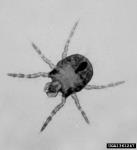COLUMBIA, Mo. – The second week of June is when chiggers begin digging into Missourians, says University of Missouri Extension entomologist Richard Houseman.
Chiggers are the tiny, immature stage of a large mite called a redbug. These colorless, parasitic larvae measure only 1/150 of an inch in diameter, but they pack a punch with their itchy bites throughout summer, not letting up until it frosts in the fall.
You’ll find chiggers wherever there is unmanaged vegetation. They crawl around, waiting to attach to a host. Birds, livestock, snakes, rodents and other animals are their natural hosts. Humans are accidental hosts, Houseman says.
Two to three generations of chiggers are produced each year in Missouri. They favor damp areas with low-growing shrubs, grass and weeds. Once on a human host, they crawl upward until they find an area where clothing fits tightly against the skin, such as waistbands, bra bands and socks, says Houseman. Then they settle in and feed. Their favorite feeding spots are the backs of knees, the crotch and in the armpits.
To feed, chiggers pierce the host’s skin with their mouthparts and inject a digestive enzyme that dissolves the skin tissues. The chigger then sucks up the dissolved epidermis as food. As they feed, the tissue around the bite hardens into a tiny tube. For three to four days, the chigger continues sucking liquefied tissue through the tube, much like a person drinking through a straw. The chigger never burrows into the skin and does not feed on blood.
Even though the chigger mite is usually scratched off and killed soon after biting, the tiny hardened tube and the digestive enzymes stay in the skin. They continue to itch and to ooze the liquefied tissues, which dry to form a hardened cap. Over a few weeks, the skin heals and the bites go away.
How to avoid chiggers
The best defense against chiggers is to avoid them.
Mowing yards is the best strategy to keep chigger populations down. If mowing is not desired, you can spray infested areas, but this only provides temporary control and may affect beneficial populations of insects and mites.
Tightly woven fabrics reduce the threat of chiggers penetrating clothing. Tuck pant legs inside boots and tightly button cuffs and collars. Launder clothing soon after visiting areas where chiggers are likely to live.
Chemical repellents ward off chiggers. Insect sprays containing DEET (diethyltoluamide) or picaridin are effective. Reapply every two to three hours. Sulfur powder also works but has a strong, unpleasant odor.
For more information, the MU Extension guide “Chiggers” (G7398) is available for free download at http://extension.missouri.edu/p/g7398.
Read more http://extension.missouri.edu/news/DisplayStory.aspx?N=2547





